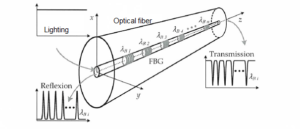 The application of fiber optic technology as temperature and strain gauges is quite surprising in bogie frames. To be more precise, these fiber optic sensors are applied for examining the carbon fiber bogie, in addition to standard surface-mounted electrical-resistance fiber optic strain gauges.
The application of fiber optic technology as temperature and strain gauges is quite surprising in bogie frames. To be more precise, these fiber optic sensors are applied for examining the carbon fiber bogie, in addition to standard surface-mounted electrical-resistance fiber optic strain gauges.
Optical fibers of 125 micrometers in diameter or 250 micrometers with a coating layer are perfect for this aim. The thing is that the optical fiber is improved to produce fiber Bragg gratings (FBG) in the fiber, efficiently producing a number of semi-reflective mirrors over short but equal intervals.
The operating principle of the FBG system is based on the reflection of the signal (a small amount of the signal at each semi-reflective mirror) when the light is transmitted through a fiber Bragg grating. Herewith, “the originally reflected wavelengths (without the influence of strain) from each Bragg grating are compared to the reflected wavelengths when the structure is loaded.”
It should be noted that in the case of FBG deformation by strain, the spacing between the semi-reflective mirrors is either enlarged (tension) or decreased (compression). Therefore, the change combined with the efficient refractive index and the period of the fiber Bragg gratings leads to a shift in the reflected central Bragg wavelength.
The thing is that the wavelength size demonstrates the strain magnitude. Nevertheless, there is the same effect that happened with temperature change, while the temperature effect is over 10 times the strain effect that is why the fiber optic technology needs to correct for temperature.
The researchers present the techniques applied to compensate for temperature where the fiber Bragg grating is placed close to the end-face of a cleaved optical fiber. The fact is the optical fiber with FBG is put in a capillary tube where one end is fused to the fiber, well away from the grating, and the opposite end is sealed. Finally, the FBG system responds only to temperature.
Nonetheless, it is not enough only to install several strain gauges into the bogie and link them to the instrumentation either. Ir is required to choose the proper fiber, for instance, bend-insensitive optical fibers are suitable. These are optical fibers where the diameter of the core includes 9.5-micrometer fibers with 4.5 mm long fiber Bragg gratings.
Additionally, it is necessary to properly install FBG systems to the bogie so as to act as a homogeneous part of the structure. Fiber Bragg gratings provide such benefits as efficient strain gauge transfer, capable to accommodate localized variations in the surface topology of the composite.
Optromix is a manufacturer of innovative fiber optic products for the global market. The company provides the most technologically advanced fiber optic solutions for the clients. Optromix produces a wide range of fiber optic devices, including cutting-edge customized fiber optic Bragg grating product line and fiber Bragg grating sensor systems. Moreover, Optromix is a top choice among the manufacturers of fiber Bragg grating monitoring systems. If you have any questions, please contact us at info@optromix.com


 Fiber optic technology
Fiber optic technology Tunnel fires are not regarded as usual, however, they also can perform great damage to lives and properties if they take place. The process of fire detection inside the lengthy and curved tunnel is challenging. Nevertheless,
Tunnel fires are not regarded as usual, however, they also can perform great damage to lives and properties if they take place. The process of fire detection inside the lengthy and curved tunnel is challenging. Nevertheless, An electrical engineer from the Netherlands has developed a
An electrical engineer from the Netherlands has developed a  A team of researchers from the U.S. continues developing a
A team of researchers from the U.S. continues developing a  A new compact
A new compact  A team of researchers offers a new application of
A team of researchers offers a new application of The opportunity to measure body temperature plays a crucial role in both physiological studies and clinical investigations. New wearable sensors based on
The opportunity to measure body temperature plays a crucial role in both physiological studies and clinical investigations. New wearable sensors based on  Fiber Bragg gratings
Fiber Bragg gratings The continuous development of high-temperature
The continuous development of high-temperature